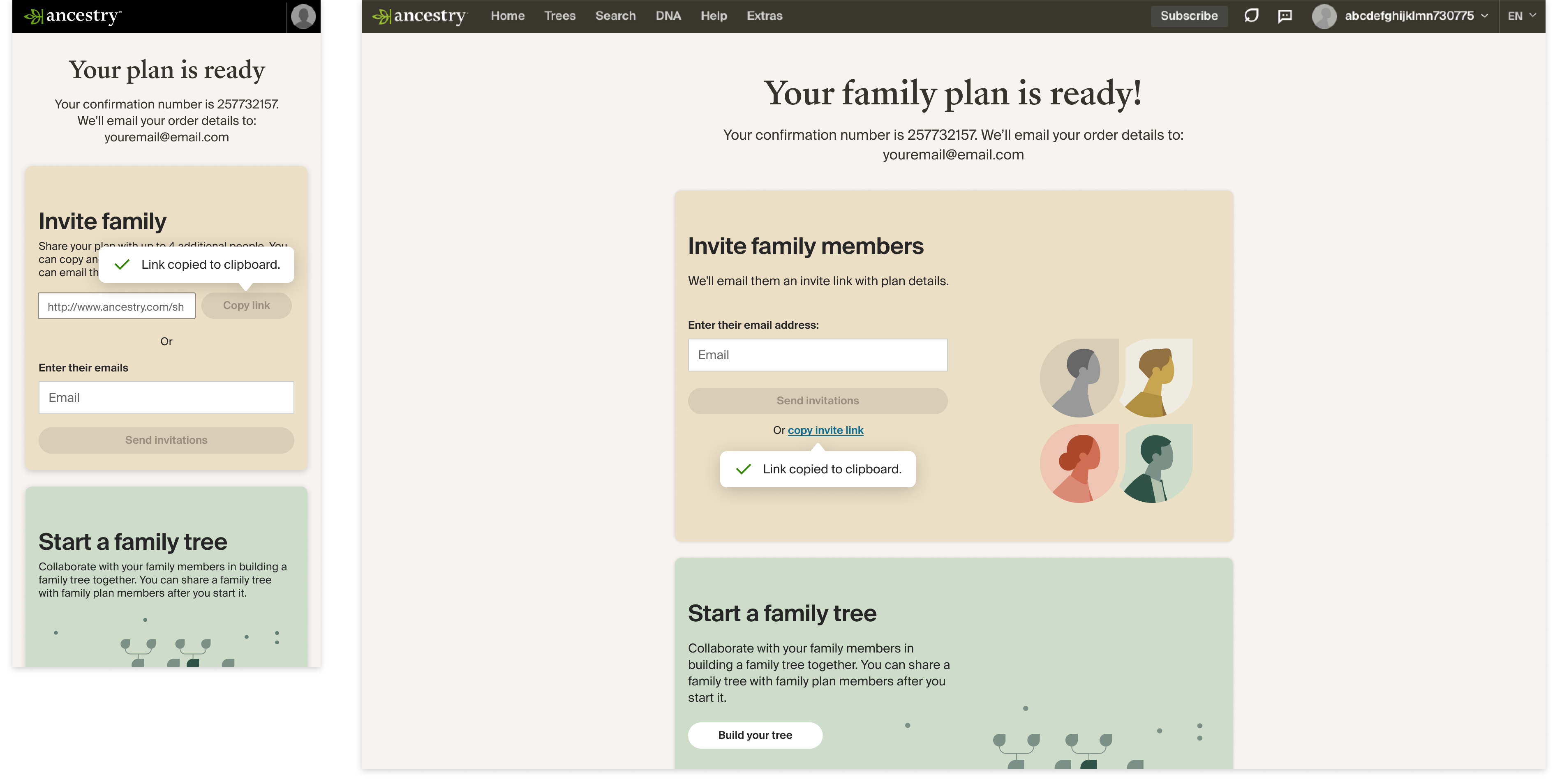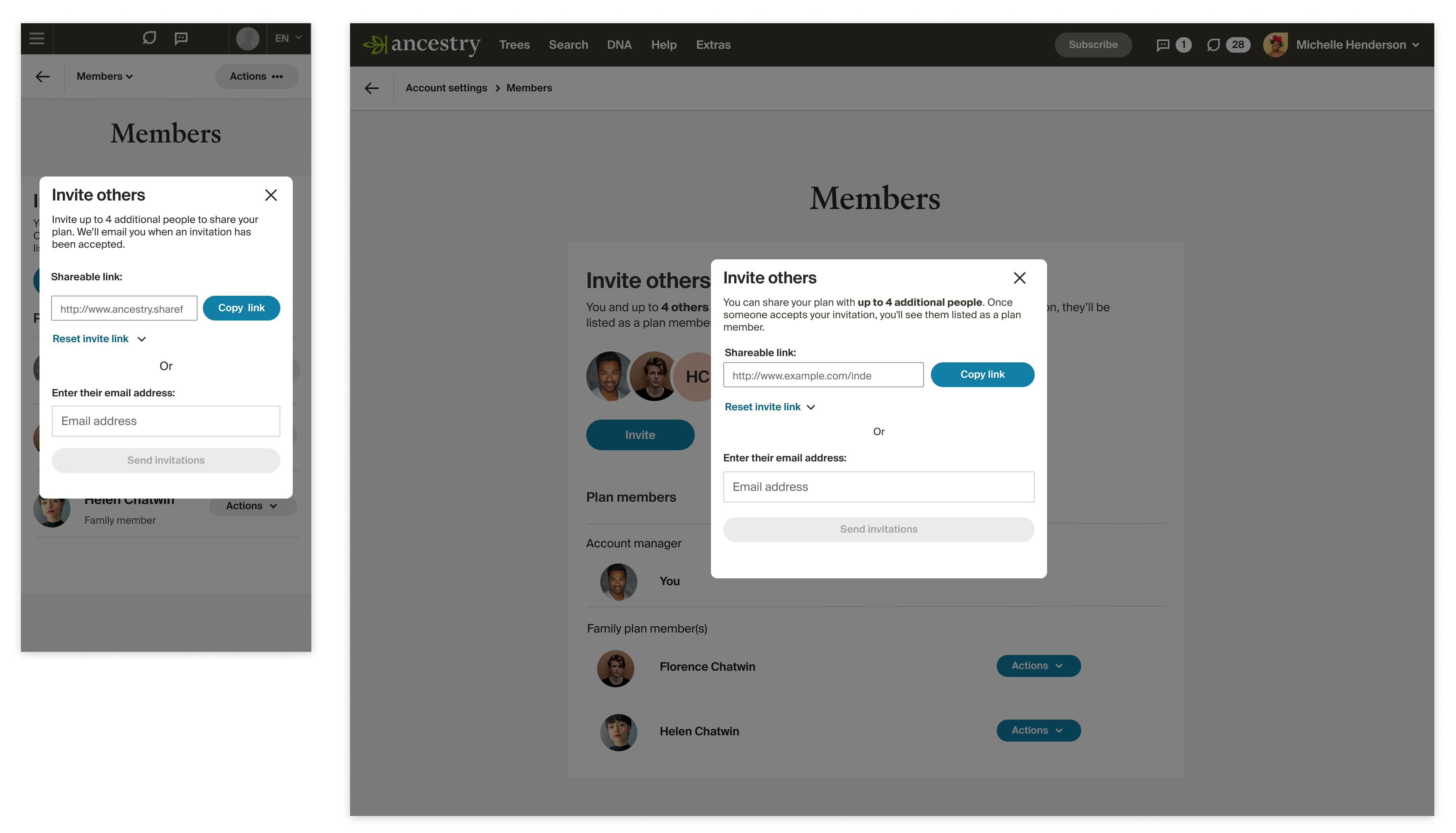Family Subscription Plan
Role: Lead Product Designer | Device: Mobile & Desktop Web | Duration: 3 Months
OVERVIEW
I was the lead designer for the new Ancestry Family Plan. I worked with marketing, e-commerce, settings, messaging, and family tree teams to deliver a complex end-to-end experience, including purchase, invite, share, settings, activation, and cancel flows.
We launched a multi-variant AB test at the end of August 2022 and got significant sign-ups (20k customers) to ship the product fully.
THE PROBLEM
From user research, we found solid baseline interest for the Family Plan. In the past, users had to share their login information with their family members to share their discoveries, get help with reviewing records, and add relatives to their family trees. The new Ancestry Family Plan gives customers plus four family and friends access to explore their family history together on one subscription.
THE SCOPE
Family plan MVP includes two major flows for plan owners and members. Owners' flows include purchase, confirmation, sharing, adding/deleting members, managing membership, setting privacy, and messaging. Plan members' flows have: accepting invites, login/sign-up, membership migration (if already subscribed), onboarding, messaging, and leaving the plan. Here is a flow chart of the steps our team was building, excluding the flows partner teams were supporting, for example, marketing and messaging.
Pic. 1 Family plan user flows
USERS
There are two major types of users in this product: plan owner and plan members, and they have very different flows and experiences. Within each type, there are two more groups of users: new customers and existing customers. New customers need to create a new account to purchase or join the plan. If existing customers already have a membership, they will need to terminate the current membership and start a new family plan. Credits or refunds will be issued once checkout or plan migration finishes.
Pic. 2 The different types of users in family plan
From survey results, we found existing Ancestry customers were more interested in purchasing the family plan. They were customers familiar with our product and the plans we offered. It's critical to ensure a smooth transition from individual membership to a shared family plan without confusion. Onboarding was essential for plan members who were invited to join. Without purchasing the plan or previous experience with the product, it could be challenging to understand how to use the product and what they could discover.
Our older customers were more likely to use Ancestry on their desktop and preferred to invite and share the membership via email. More younger customers and intenders prefer to use mobile devices, and it's more convenient for them to copy URL links and share via messages. Thus for different devices and users, we would make different methods as primary CTAs.
"If I could add just one more person (rather than the over broad ‘up to five’) at a lower incremental price then I might very well choose that. I have one, perhaps even two family members I think I might want to contribute and who might be interested in doing so. Five is a stretch."
"I think the transparency of being able to view one another's trees will increase the likelihood of collaboration among family members."
DESIGN
The biggest challenge we had with this project was defining the exact specs of the MVP. There was too much ambiguity in the actual functions and actions within each flow to design an end-to-end new product. With limitations on supporting feature teams, we could not build the most ideal experience. We raised the questions and work with PM and UXR to get clarity to help with wireframing and creating the final designs.
QUESTIONS
To design this new product, we had several questions to answer before we start creating flows and wireframes. Here are some of the questions for example:
- What are the additional new features/flows we need to create to support this new plan?
- What are the default privacy controls between plan owner and guests?
- Will it be billed altogether or individually? Who will have access to billing?
- Who will have access to adding and deleting plan members?
- What are the channels we need to support for inviting and sharing?

Pic. 1 User research findings on account preferences of account owners
SPECS
Based on quantitative and qualitative research, the limitations of the project scope, we strategized and made granular design decisions, including:
- Plan owner can invite up to 4 additional members to create or login their own accounts to join the family plan.
- Family plan membership will be purchased and billed to the plan owner for the MVP.
- Plan owner can manage both the members in the plan and the membership itself.
- Plan members cannot change the membership settings but can leave the family plan.
- The invitation can be shared via url link and emails.
We created flows and wireframes based on the design decisions to get stakeholders' buy-in, then iterated and created prototypes for user testing. After a few more iterations, we completed the handoff design for engineering.
PURCHASE & INVITE

Pic. 3 Purchase flow for plan owners

Pic. 4 Invitation on confirmation page
SETTINGS

Pic. 5 Family plan settings for plan owners

Pic. 6 Managing plan membership in settings

Pic. 7 Invitation in settings
PLAN MEMBERS

Pic. 9 Invitation page to join the plan

Pic. 10 Limited settings for plan members
REFLECTION
The end-to-end flow for the family plan is very complex, and we had many limitations on what functions and features we could provide to the customers. Many features that customers were interested in to collaborate and help members in their family plan were out of scope.
With the limitations on the scope and support from other feature teams, we were able to finalize the flows, test, ship, and get positive signals to launch the new product fully. We hope to prioritize the supporting features in the coming quarters to provide family plan members with more guidance and collaboration functionalities.